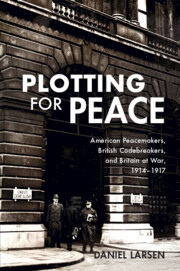Book contents
- Plotting for Peace
- Plotting for Peace
- Copyright page
- Dedication
- Contents
- Figures
- Map
- Graph and Table
- Dramatis Personae
- Preface
- Acknowledgements
- Maps
- Introduction
- 1 The First Year of War
- 2 Strategy
- 3 Negotiations
- 4 Deliberations
- 5 The Gamble
- 6 The Knock-Out Blow
- 7 The Fall of Asquith
- 8 Peace Moves
- 9 The Zimmermann Telegram and Wilson’s Move to War
- Conclusion
- Book part
- Notes
- Bibliography
- Index
3 - Negotiations
January–March 1916
Published online by Cambridge University Press: 26 March 2021
- Plotting for Peace
- Plotting for Peace
- Copyright page
- Dedication
- Contents
- Figures
- Map
- Graph and Table
- Dramatis Personae
- Preface
- Acknowledgements
- Maps
- Introduction
- 1 The First Year of War
- 2 Strategy
- 3 Negotiations
- 4 Deliberations
- 5 The Gamble
- 6 The Knock-Out Blow
- 7 The Fall of Asquith
- 8 Peace Moves
- 9 The Zimmermann Telegram and Wilson’s Move to War
- Conclusion
- Book part
- Notes
- Bibliography
- Index
Summary
In the aftermath of German-American diplomatic crisis over submarines, House conceived a new, more ambitious strategy of trying to use US power to end the war and prevent an Allied defeat. Although House initially struggled to find a receptive audience amongst the British leadership, anxiety within the British government was on the rise. Efforts to reconcile Britain's economic and military strategies settled on a plan to win the war with a great 1916 offensive – a strategy that provoked serious disquiet amongst a number of key British leaders. By February 1916, a number of British leaders, including Foreign Secretary Sir Edward Grey, encouraged House towards a still more ambitious conception of American mediation: not only would the United States play a key role in setting up the negotiations, but it would also chair them. House and Grey agreed the 'House-Grey Memorandum', in which House promised that the United States would guarantee a set of limited Allied war aims at a peace conference. All the while, British intelligence was decrypting House's telegrams and attempting to undermine his negotiations.
Keywords
- Type
- Chapter
- Information
- Plotting for PeaceAmerican Peacemakers, British Codebreakers, and Britain at War, 1914–1917, pp. 71 - 103Publisher: Cambridge University PressPrint publication year: 2021

